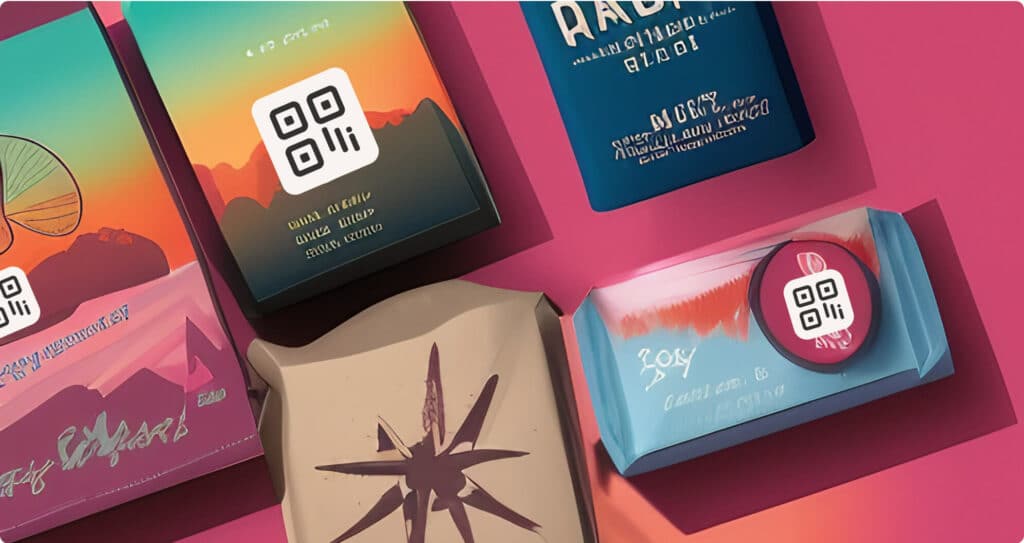What is GS1 digital link, and why does it matter?
GS1 digital link (also known as 2D barcode) is an innovative standard connecting physical products to dynamic digital content and experiences. Encoding web URIs into barcodes and QR codes bridges the gap between offline and online.
This new initiative creates a portal between the physical product and online brand experiences, information sources, apps, and more. Scanning a single barcode on a product packaging can instantly unlock access to digital content tailored for the specific user with GS1 Digital Link.

Some of the capabilities unlocked by the GS1 digital link standard include:
- Omnichannel flexibility – the same codes can link to different experiences optimized for the context, like at point of sale vs. on e-commerce.
- Enhanced traceability – products can be digitally identified and tracked across the supply chain to the item level.
- Transparency – easy access to detailed information on demand, like ingredients, sourcing, and manufacturing.
- Seamless compliance – required data like expiration dates and nutrition facts can be shared digitally via the codes.
- Consumer experience – scanning codes drives opportunities for promotions, reviews, brand loyalty programs, and more.
- Extended product experiences – provide additional content like demos, how-to videos, and recipes.
- Improved business insights – gain additional data on product usage and lifecycle analytics.
GS1 digital link delivers a standardized way to give every product a unique digital identity. This lays the groundwork for an Internet of Things environment where smart products become the norm.
The implications across packaged goods, retail, healthcare, and other industries are enormous. GS1 digital link or 2D barcodes unlocks the ability to market, manage, track, and analyze products in new ways.
GS1 US plays a pivotal role in driving the adoption of the GS1 Digital Link standard across various industries in the United States. By using the GS1 Digital Link, GS1 US makes it possible trading partners enhance product traceability and consumer engagement through innovative digital technologies. GS1 US ensures that companies and their trading partners can seamlessly integrate using the GS1 Digital Link into their supply chains, improving efficiency and transparency in product information sharing.
How does GS1 digital link technology work?
A GS1 digital link is a barcode combined with web addresses. To make this simple yet incredibly powerful technology work, it’s vital to understand how the link must be constructed and how the connected information and content are retrieved and distributed.
URI structure
A GS1 digital link URI is a web address formatted to contain a product’s unique GS1 identifier (like a GTIN number). The URI structure connects physical objects to online digital identities.
For example:
https://brand.com/01/01234567890123
The URI syntax follows a standardized structure defined in the GS1 digital link specifications:
- Domain – The brand’s or company’s owned web domain.
- Primary ID Key – A GS1 Application Identifier (AI) indicating the type of identifier used, such as GTIN-13, GTIN-14, SSCC, etc.
- Identifier – The actual product identification number based on the AI key. For example, the 12-digit UPC.
- Qualifiers – Optional additional IDs such as batch number, serial number, etc.
- Attributes – Optional data points like weight, dimensions, and expiration dates.
When encoded and scanned, the URI enables the lookup of the product’s digital identity and associated information.
Resolvers
A server called a GS1 digital link resolver is required to translate a GS1 digital link or 2D barcode URI into meaningful product data. Resolving services bridge the connection between the physical and digital worlds.
When a GS1 digital link is scanned, the resolver receives the URI and looks up the product’s identity based on the identifier contained in the URI structure.
Resolvers perform several vital functions:
- Fetching associated digital content – Product info, attributes, media, web experiences, etc.
- Checking the validity of product identifiers – Confirming the GTIN or SKU is officially registered.
- Rerouting based on context – Redirecting to different experiences based on who, where, and how the code is scanned.
For example, the resolver can return pricing and inventory information when scanned during checkout at a retailer versus providing a product video when scanned by a consumer’s smartphone.
Data carriers
To attach GS1 digital links to physical products, the URI must be encoded into optical data carriers like a QR code or Data Matrix, which can be printed on the packaging.
QR codes are an obvious choice here, especially since the evolution of high-definition professional printers has made it possible to reduce the minimum size of QR codes to 5mm, keeping them readable by devices.

Why implement GS1 digital link?
Omnichannel flexibility
GS1 digital link standard enables seamless consumer experiences across physical and digital touchpoints.
The flexibility of the standard means that a single QR code can adapt and resolve to various destinations depending on the context.
For example, the code may link to different resources depending on the Country where it is scanned, the time of day when it is scanned, or other variables like if it’s scanned inside a point of sale, the type of device used, or the weather.
This context-aware capability provides consistency for consumers across brick-and-mortar stores, e-commerce sites, mobile apps, business partner, grocery store, point of sale, and more.
Supply chain visibility
Real-time visibility and connectivity enabled by GS1 digital link or 2D barcode improve global trade supply chain operations efficiency.
Manufacturers can gain insights into raw materials and components used, actors in the retail industry can track inventory across locations, and logistics providers and business partner can pinpoint shipments in real time.
This unprecedented visibility at the individual product level improves traceability, reduces manual errors, speeds up recalls, and enables data-driven decisions to optimize supply chain productivity.

Shopper engagement
On-demand product data allows a brand owner to interact directly with customers and provide transparency into products.
Consumers increasingly want to know details like where an item was made, its expiration date, ingredients, allergen information, sustainability credentials, and more.
The GS1 digital link standard creates a way to instantly access this product data from the package via mobile devices.
Regulatory compliance
Digitally sharing required data, certifications, and ingredients simplifies compliance.
Regulations require more product transparency, especially in the food and beverage and healthcare industries—for example, FDA nutrition labeling requirements in the US or EU regulations mandating Digital Product Passports.
By digitally centralizing required compliance assets like documentation, certifications, and ingredients via GS1 digital link or 2D barcode, a brand owner can more efficiently fulfill regulatory obligations.
Future-proofing
The GS1 Digital Link standard, also known as the 2D barcode, is essential for the future of connected IoT products and compliance with track-and-trace regulations. With a 2027 deadline for transitioning from linear to 2D barcodes, known as Sunrise 2027, there’s an urgency for brands to adopt this technology now to stay competitive and compliant. Starting implementation today helps brands future-proof their operations and ensure they meet upcoming standards.
GS1 digital link applications and use cases
GS1 digital link or 2D barcodes opens new opportunities for companies across retail, consumer packaged goods, manufacturing, healthcare, logistics, and technology. It provides a standardized way to connect physical things to digital experiences and information.
The use cases span from enhancing shopper engagement, optimizing supply chain operations, simplifying compliance, and much more.
Shopper engagement
For brand marketers, GS1 digital link creates a seamless experience across packaging, digital ads, websites, and apps.
Scannable codes turn products into launching points for broader consumer experiences.
Specific applications include:
- Product education – Share videos on ingredients, sustainability, manufacturing process, etc.
- Consumer support – Enable self-help instructions, FAQs, chatbots
- Digital hub – Link to online content like recipes, tutorials, and tips and tricks
- Social sharing – Encourage sharing reviews, photos, and experiences
- Brand loyalty programs – Direct to membership portals and exclusive offers
- Coupons/promotions – Deliver special deals, sweepstakes entries, rebates
- App adoption – Prompt download and onboarding for brand apps

Supply chain operations
GS1 digital link improves logistics traceability, operational efficiency, and decision-making for supply chain roles.
Critical use cases include:
- Inventory management – Access real-time inventory across a network of sites
- Order fulfillment – Pick/pack orders by scanning items rather than manual entry
- Shipping/logistics – Track individual item locations and status throughout transit
- Recall management – Rapidly identify affected products down to exact batches or serial numbers
- Replenishment – Automate ordering and workflows based on low-stock alerts
- Returns – Scan products to pull up associated order information
- Quality control – Pinpoint products tested and produced during specific times
Regulatory compliance
GS1 digital link or 2D barcode simplifies sharing required product info like ingredients, expiration, and sustainability credentials.
Applications include:
- Ingredient declarations – Provide consumer access to allergen info, nutrition facts, etc.
- Certifications – Share organic, fairtrade, and other ethical sourcing credentials
- Manufacturer info – Link to details on testing, quality control, and facilities
- Expiration dates – Manage usability timeframes and freshness
- Environmental metrics – Provide consumers with carbon footprint, energy usage, and sustainability impact data
- Digital batch records – Digitize production processes and protocols
The applications of GS1 digital link span far beyond this list, but it provides a snapshot of the diverse possibilities across sectors.
Get started with GS1 digital link
For brands looking to implement GS1 digital link, there are key steps to set your program up for success.
Select the data carrier
One important thing to do is to choose which data carrier will encode the GS1 digital link or 2D barcodes. This is what gets printed and applied to the physical products.
The popular choice for consumer engagement is QRs which can be scanned easily from packaging using smartphones.
Build digital link URIs
With the data carrier determined, it’s time to construct the actual GS1 digital link URIs. This is where the GS1 standards come into play.
URIs must follow the proper syntax and structure outlined in the GS1 digital link or 2D barcode specification. This includes the domain, identifier type, GTIN values, qualifiers like batch and serial numbers, and attributes like expiration date and quantity.
A GS1 Digital link generated on our platform are automatically validated to ensure the URIs are correctly formatted.
Set up the resolver
Another critical component is deploying the resolving service to process the GS1 digital links.
When the codes are scanned, the resolver receives the URIs and converts them into relevant responses. This includes fetching associated data and directing users to the appropriate endpoints.
The service provided by digital-link.com includes resolving capabilities that would otherwise require considerable effort and investment to establish.
Connect experiences
The final stage is connecting the GS1 digital link or 2D barcodes to the online brand loyalty experiences, content, information sources, apps, and tools you want people to access by scanning products. This includes setting up product pages, portals, videos, promotions, and more.
Fortunately, digital-link.com automatically creates for you a GS1 digital link, a Digital product passport, and a dynamic QR code with a simple product GTIN.

Conclusion
GS1 Digital Link is revolutionizing global trade by connecting physical and digital products, requiring adherence to specific standards and technology. Digital-link.com offers a SaaS solution to help brands quickly generate GS1 digital links, digitize their products, and measure performance through detailed analytics. To get started, contact their experts at info@digital-link.com or use their live chat.




